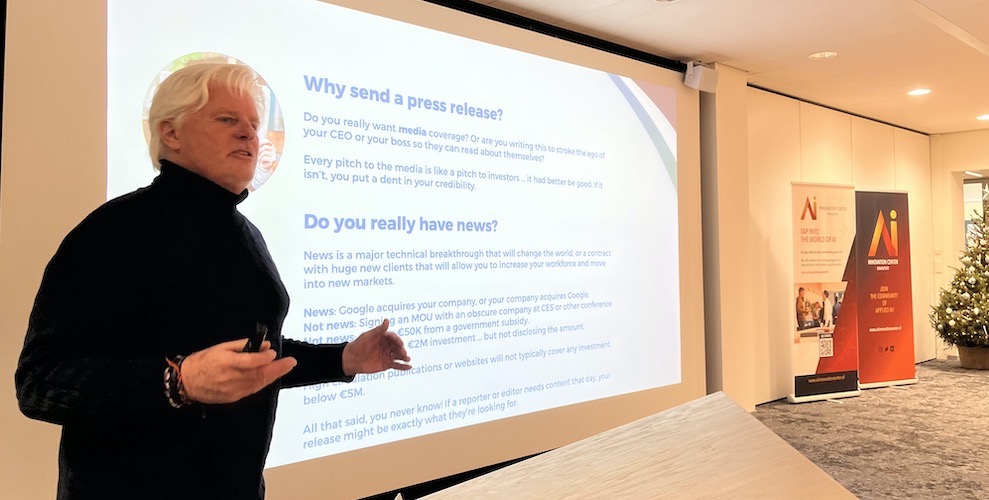(Editor’s note: This post on crafting the perfect news release is part of our Tech Tuesday series. Dispatches works with startups, providing – among other things – news releases and other marketing content. This is taken from a Lunch & Learn event earlier this month at the AI Innovation Center on High Tech Campus Eindhoven.)
When you get positive coverage from an influential outlet, that automatically does two things – it anoints you with the credibility of an established company, and it creates your search profile. When investors Google your company, detailed information will come up.
That’s a good thing.
Because if your startup or scale-up doesn’t have any searchable info on the Web, it doesn’t exist.
I’ve been a journalist for decades, and I’ve founded or co-founded three media companies. I have seen literally thousands of media releases. Maybe 10 percent were worthy of coverage, and maybe 2 percent were useful, with relevant information.
Most were information free, full of flowery language and tautology … and ended up in my wastebasket.
It’s important to do this right!

Do’s and Don’ts
DO’S
• You MUST have someone willing to be interviewed. Don’t send a release if your CEO isn’t available for interviews. So many times, I asked to interview the main person in the release only to be told, “He/she doesn’t speak to the media.” Reporters don’t want to interview your media relations person.
• Have a native speaker proofread and/or edit your press release. No misspellings or grammatical errors allowed.
• Cultivate your relationship with the media. If you have big news, you can set the terms of who covers it and how. Know who works where and who’s influential.
DON’TS
• Don’t embargo press releases. Ever. Just distribute the release when you’re ready. If you simply must embargo a release, call the editor before you send it to make certain they’ll honor the embargo. This is a negotiation. You have no control over what the media do with unsolicited information they never asked for.
• Don’t send a news release without hard numbers. EVER. “A significant investment …” won’t do it. A $10 million A round from a major investor … that’s news. Is a reporter supposed to assess the newsworthiness of what you’re pitching without some empirical data?
• Don’t include a bunch of gratuitous quotes. A reporter will want a release that’s a quick read, with all the details that will allow him or her to turn around a quick story. They’re not going to use every repetitious quote from your CEO, from all the founders and from investors. Just go with what’s important.
• Don’t pitch incorrect information. Double-check your facts. You could look really, really bad in print for thousands of people to see.
• Don’t try to pitch a story about something that happened weeks ago or isn’t going to happen for months (or years). A big pet peeve of mine and just about every other journalist. NEWS HAS A SHELF LIFE. Otherwise, it’s history.
Why are you doing this?
Do you really want media coverage? Or are you writing this to stroke the ego of your CEO/boss so they can read about themselves? Every pitch to the media is like a pitch to investors … it had better be good.
Do you even really have news?
News is when Google acquires your company, or your company acquires Google. Okay, that’s hyperbole, but you get the idea.
For example, signing an MOU at CES with some obscure company … not news. Getting a few thousand euros in a government subsidy … not news. High-circ pubs typically will not cover any investment below 5 million euros.
News is a major technical breakthrough that will change the world, or a contract with huge new clients that will allow your startup or scale-up to increase your workforce and move into new markets.
All that said, you never know because if a reporter or editor needs content that day, then your release might be exactly what they’re looking for.
Who is your audience?
There’s the conventional media. There’s the financial media. And there are the industry websites and publications. Know the difference!
The media is changing
In the digital age, most companies don’t have the budget for a lot of reporters and editors. That’s good and bad. The good news is, if your release is clear and detailed, the publication could put it on their landing page with only a light edit. Everyone wins.
SOMEONE on your team needs to understand the media and have actual connections to the reporters covering startups and tech.
The format
Start with the date and the dateline. The dateline is where you are: “EINDHOVEN” in all caps.
Starts with the date and the dateline. The dateline is where you are. “Eindhoven” or “Berlin” or wherever.
December 26, 2023
FOR IMMEDIATE RELEASE
EINDHOVEN, The Netherlands –
The lede
Reporters start stories with the lede sentence. “Today, Intel acquired ASML in a deal valued at $20 billion.” The core information goes first. Reporters also use something called a “nut graph.” There, they condense into one paragraph the essence of the story. “With the acquisition of ASML and its advanced photolithography machines, Intel became the most dominant semiconductor firm in the world.”
The boilerplate
End with the boilerplate, informative text about your company. Keep it brief, 1-2 short paragraphs. Just the facts: founding date, founders, location, funding, customers, product.
Here’s a great example:
“Salesforce is the global leader in Customer Relationship Management (CRM), bringing companies closer to their customers in the digital age. Founded in 1999, Salesforce enables companies of every size and industry to take advantage of powerful technologies – cloud, mobile, social, internet of things, artificial
intelligence, voice and blockchain – to create a 360° view of their customers. For more information about Salesforce (NYSE: CRM), visit: www.salesforce.com.”
The email:
Send the entire press release in the body of an email. Add your message at the top, add a few returns or a line, then add the press release.
Whatever you do, DO NOT send the press release as an attachment. Drop it and one or two high-res photos into the email.
A reporter will want a release that’s a quick read, with all the details that will allow him or her to turn around a quick story.
You have to really just go with what’s important.
If you want to know more about how to deal with the media, email me at: [email protected]
Co-CEO of Dispatches Europe. A former military reporter, I'm a serial expat who has lived in France, Turkey, Germany and the Netherlands.















